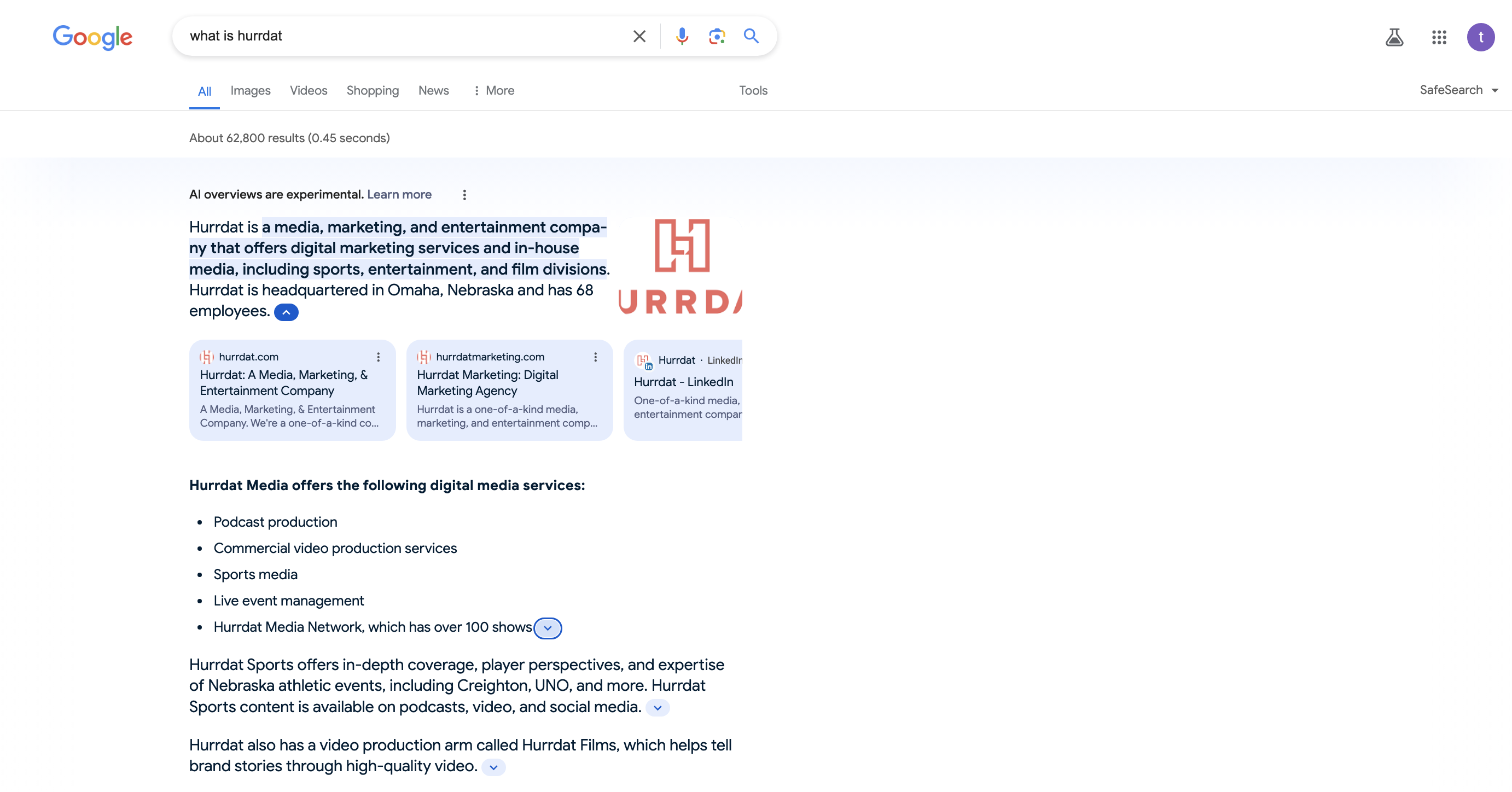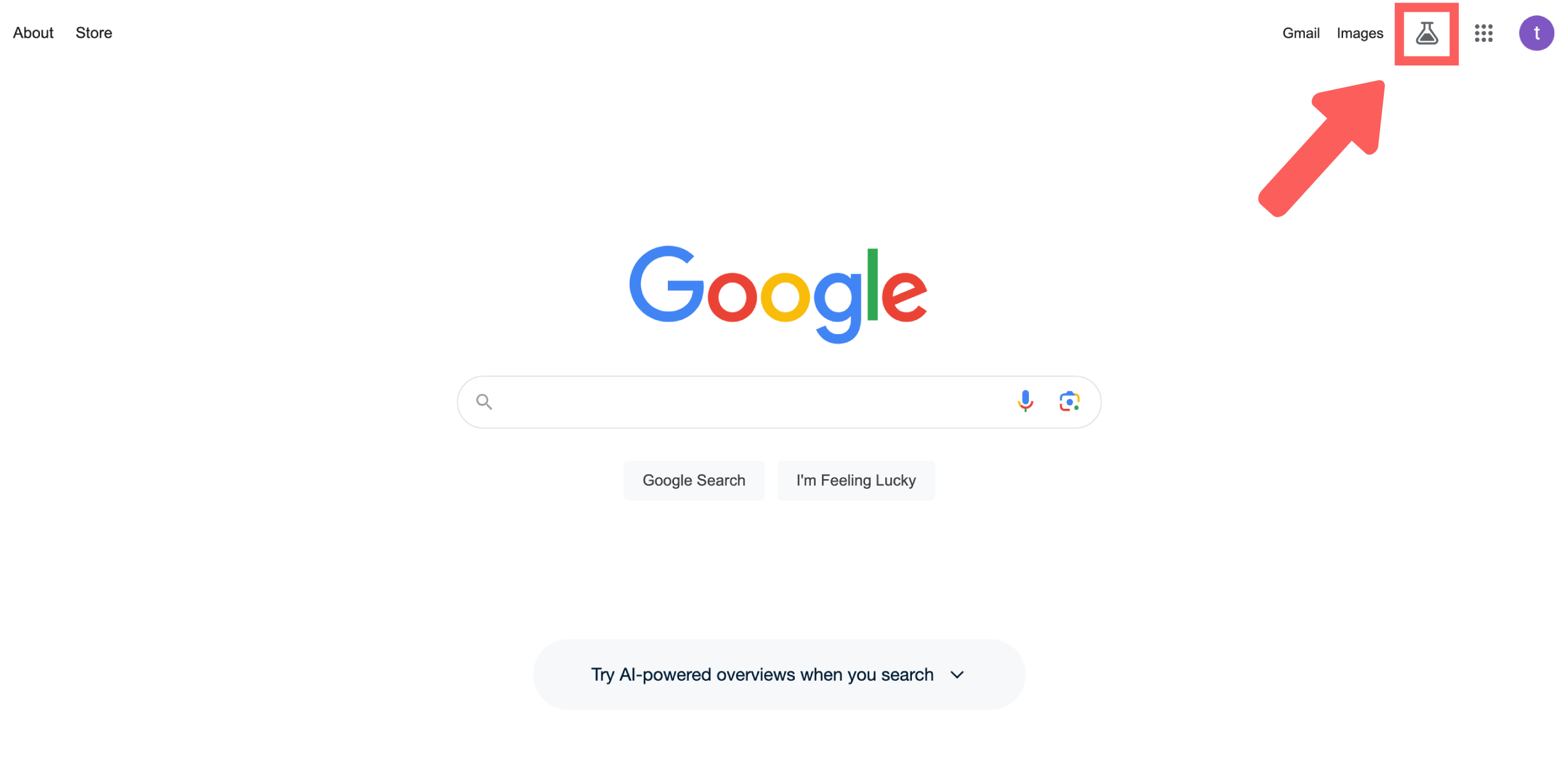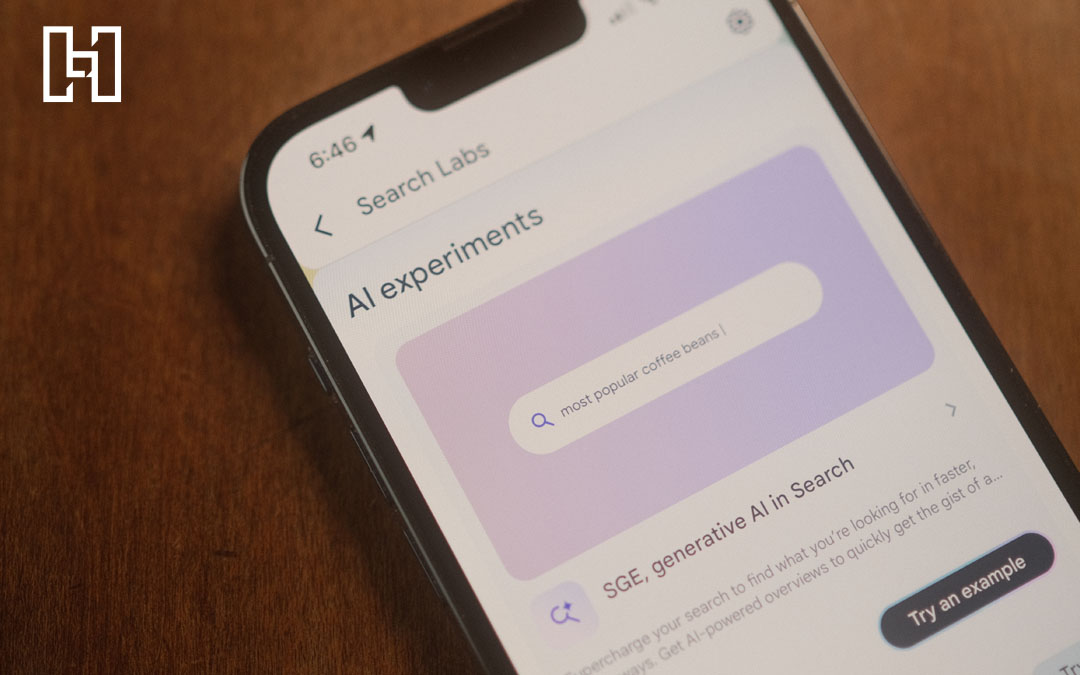Google’s generative AI search tools have recently expanded to over 120 countries, and AI-powered online searches are gathering the interest of roughly half of U.S. adults. Keep your business’ online presence competitive and learn more on Google SGE with this guide.
- What Is Google SGE?
- Benefits of Google’s Generative AI Search
- Drawbacks of Google’s Generative AI Search
- What Does Generative AI Search Mean for SEO?
- How to Adapt Your Website for Google SGE

What Is Google SGE?
Google Search Generative Experience (SGE) is an experimental feature using generative AI to provide search results. It runs on large language models (LLMs), which are trained on large sets of data to better understand user queries. SGE quickly summarizes key takeaways, generates imagery, and suggests follow-up searches based on the previous query.

These results appear at the top of SERPs, and because of their quality and convenience for searchers, are one of the most effective ways to reach audiences—next to zero-click searches.
Although this feature is not automatically available, Google has started testing AI overviews for a small percentage of users who haven’t opted in. For more consistency, you can enable the feature by logging into your account, opening a new tab, clicking on the “Labs” (flask) icon in the top right, and turning on SGE.

Benefits of Google’s Generative AI Search
For people searching online, the addition of AI-powered search provides more comprehensive results and easy-to-understand takeaways, while businesses can enjoy increased customer insights and brand engagement. Here are some of the benefits of Google SGE for companies.
Increased Brand Awareness
Google SGE works by combing through relevant results to your query and synthesizing that information into a single, concise response. But roughly 93% of AI-generated answers do not come from Google’s top ten organic search results. So, if your business doesn’t currently rank well in SERPs but is optimized for Google’s E-E-A-T, you might have a new opportunity to put your brand in front of searchers.
Improved UX Design
It’s been Google’s mission to be as helpful to searchers as possible in recent years, and Google SGE is just one more way to accomplish that goal. With its user-friendly elements like bullet points, numbered steps, and AI-generated images related to the search query, people can find answers to what they’re searching for without friction or an inconsistent online experience. This is a big win for businesses who haven’t prioritized these UX features on their own blog or website, since SGE automatically formats your content in a way that’s best for potential customers to learn about your business.
Higher Engagement
Because Google SGE gives quick answers to questions without requiring searchers to click through to websites, there’s a worry that AI search will reduce engagement. But the opposite may be true. SGE’s new “follow up” search bar feature and more complete answers to queries can lead searchers to explore related topics that they might not have known they had when asking their initial question. This keeps them exploring longer.

As a result, this new search experience filters out higher-funnel traffic, making those who do end up clicking through to your website higher quality leads with a stronger conversion intent.
More Content Strategy Insights
Google SGE is just one more tool for you to analyze if you want to strengthen your content. Much like a SERP analysis, reviewing Google SGE results can help you uncover user intent, identify content gaps, and reveal which content formats (like text, videos, infographics, and more) are being rewarded for specific searches. Then, you should use that information to tailor your content to directly address searchers’ needs and outperform competitors.
Drawbacks of Google’s Generative AI Search
While generative AI search can provide advanced search results, it’s still in an experimental phase and comes with limitations that have the potential to cause issues for brands. These are some drawbacks of Google SGE.
Lack of Direct Attribution
Generative AI is trained on the data it accesses, but it may not always clearly state where its information comes from. Google SGE uses only a few links when featuring summaries, so it may be sourcing your business’ content without giving you credit or traffic to your website. And on occasion, it may improperly attribute sources to the result, misleading searchers to your website for services you do not offer.
Not Transparent
It’s difficult to track how many Google SGE results your business appears in or measure its impact on your website traffic. Right now, the best method to track pages that are being pulled into SGE results is to identify featured snippets with keyword tools and then manually review SERPs to see if that content is also being used in AI search.
Another roadblock with Google SGE is that the ranking factors are more unclear and inconsistent than traditional search results. Aaron Mackel, Hurrdat’s Digital Strategy Director, explains,
“We also don’t fully understand why sites rank where they do yet. In traditional search results, rankings were based (in part) on the intent, whereas some content will end up in SGE without directly relating to the query. In other words, Google SGE’s rankings are more vague and may favor more holistic approaches.”
Inaccurate Information
Due to its experimental nature, Google SGE frequently encounters issues that require further testing. One is that Google SGE may be biased because the search engine pulls whatever information is currently available on the internet. This problem is heightened for queries with complex dilemmas or few sources. In these instances, Google could provide false or irrelevant information about your business known as hallucinations, which could damage your reputation with potential customers.
Another issue is with results that rely on user-generated content (like reviews). They may skew opinions in a specific way, unintentionally casting your business in a negative light.
Lower Click-Through Rate (CTR)
The rise of SGE has the potential to greatly impact the visibility and traffic of both paid and organic search results. Traditionally, the highest-paid search position on a SERP is position zero. However, generative AI results appear above those results, giving them immediate priority.
Although websites are still linked as sources and search ads still appear in dedicated slots, the presence of SGE is still likely to negatively impact CTRs and attract fewer visitors. This is especially impactful for businesses ranking lower in the SERP, as SGE results occupy space above the fold and limit Google ad space.
Limited Availability
SGE isn’t yet available in all countries, or even all regions of the Americas, Asia, and Europe. And since Google SGE is still in the testing phase, many users who want to use it will have to go out of their way to manually activate Google SGE. For those who do use this search feature regularly, you may notice that over 20% of queries still do not have AI-enabled answers. Because of these limitations, SGE has yet to reach widespread consumer use and availability, making it a less attractive option for brands with global audiences.
What Does Generative AI Search Mean for SEO?
About 84% of search queries will be impacted by SGE, and the customer journey will be greatly influenced by AI-generated content in the future. Since Google is ranking generative AI results above traditional results, this makes managing your search presence more complex but more rewarding. Content ranking outside SGE will see a drop in traffic, but those appearing within Google SGE’s related sources or side links could potentially drive significant traffic to their websites.
Mackel adds,
“Google SGE presents an opportunity for businesses to stay ahead of the curve and see significant results the more it’s widely introduced. But it also creates more challenges, as it’s harder to consistently drive traffic and appear within SGE.”
So for as long as SGE remains unpredictable, focusing on SERP optimization is the most reliable way to rank. But the time investment and pivot in SEO strategy might be worth the gamble if your business can afford to take a few risks with a potentially high payoff.
How to Adapt Your Website for Google SGE
Although adapting your website for Google AI searches is still an uncertain process, adapting for internal standards, like Google’s E-E-A-T guidelines, is highly recommended. By focusing on common on-page and off-page SEO factors, you can sufficiently prepare for Google SGE by developing content that displays experience, expertise, authority, and trustworthiness.
Build Helpful Content
First and foremost, all of your content should be valuable to your audience and match their search intent. This is best practice for Google’s helpful content update, so without great content, you have slim chances of being featured in Google SGE results.
Mackel suggests,
“Ranking for SGE has typically involved writing comprehensive pages that cover topics in-depth. More specific articles that are focused on a certain sub-topic tend to rank well. But broader guides are also helpful for SGE rankings. Google SGE also tends to feature visuals in its results, so creating original images or unique infographics could be an important factor in boosting visibility.”
Improve Readability
Creating content that’s easy to read and understand is more important than ever as Google parses your website for elements to include in AI search. In order to improve website readability, use simple language, short sentences, and a fluid writing style. Keep your tone conversational to appeal to readers and make your writing more memorable. Structurally, your website may have a better chance in SERPs if you add schema markup and highlight key information to get featured in rich snippets.
Provide Concise Answers
Users want their queries answered fast. On average, people will only spend about 5.5 seconds looking at a website’s written content. So, yours should have direct answers front and center—right after a question header, in key takeaway boxes, in visuals, as the first and last sentences of paragraphs, or in other places where a reader’s eye is naturally drawn. These quick answers—especially ones that target long-tail target keywords—have a better chance of capturing featured snippets and, in turn, being used in SGE search.
Add Internal Links
Adding internal and external links not only improves user experience but also helps your page stand out as a trustworthy source of information. It also makes it easier for Google to crawl and index your website and pull your content for AI search. Follow internal linking best practices like rich anchor text, nofollow tags, and strategic placement so that bots can discover and spotlight your content.
Use Quotes & Statistics
In order to reduce bias and provide accurate information for its users, Google SGE is likely to prioritize sources with direct quotations and primary data. Original quotes and stats position your brand as an industry leader and target Google’s expertise requirement in E-E-A-T. On your website or blog, your business can publish customer testimonials, expert interviews, or employee spotlights to feature unique quotes. For primary data, you might conduct surveys or polls with your audience and compile the results. Or your focus could be on data-driven blog posts and case studies.
Looking for ways to optimize your SEO strategy for Google SGE? Hurrdat Marketing has a variety of SEO services to help you adapt to upcoming trends. Contact us today to learn more!



